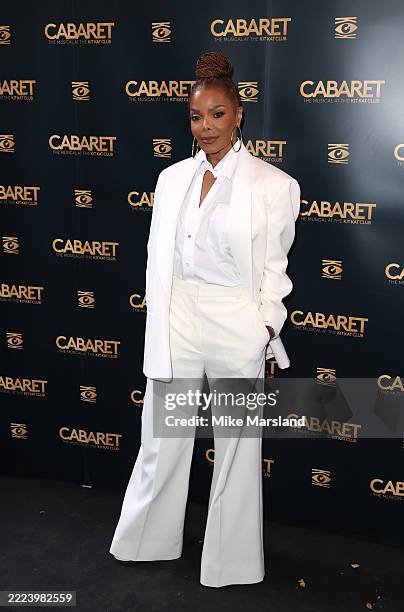Janet Jackson made a resounding statement with her sartorial choices at the 1500th gala performance of ‘Cabaret’ in London, held this past Monday. She put forward the concept of power dressing in a striking, all-white ensemble designed by Stella McCartney. The outfit displayed an exquisite blend of sharp, tailored lines, featuring high-waisted white trousers that projected a sleek silhouette. She harmoniously paired the trousers with a classy button-down collared shirt and a matching blazer.
The ‘All for You’ songstress accented her outfit with a pair of daring hoop earrings crafted in metallic silver. Not only did these statement accessories shimmer, but they also echoed the prevailing trend of bold, eye-catching jewelry. Adding further to her bewitching look, she sported several glossy silver rings, emphasizing the monochrome theme of her attire.
To round off her compelling look, Jackson opted for a strong makeup approach. She featured prominent lined eyes and audaciously defined eyebrows, highlighting her expressive gaze. Her lips were lightly glossed, a subtle finish that effortlessly complemented the power dressing concept.
Jackson’s hairstyle was equally striking, surely fashioned to align with her power dressing outfit. She chose to style her hair in an intricate braid wrapped into a neat bun. This hairstyle choice not just exuded elegance but also reinforced the style quotient and professionalism associated with power dressing.
Through her attire, Jackson has shed light on the rising trend in women’s fashion – tailored outfits. It’s a trend that has seen a sharp increase in popularity in recent years, thanks to various public figures, whose visual endorsements have significantly contributed.
There has been a noticeable shift in the fashion landscape, with more emphasis on sustainability, individuality, and rejection of the fast fashion industry. For instance, the professional woman’s attire has evolved to reflect her growing confidence, style, and burgeoning leadership roles, demanding high-quality and tailor-made outfits.
This shift in tailored clothing for women is not a new phenomenon but rather a resurgence of an established tradition. The 1980s, for instance, saw a high volume of tailored suits for women. Notable figureheads like the late Princess Diana played a significant role in popularizing this trend.
The tailoring trend was embraced by royal women across Europe, enhancing their regal image with a contemporary style twist. Queen Letizia of Spain and Kate Middleton are some of the leading royal figures who have favored this form of styling, maintaining the legacy of sophisticated fashion.
Taking the cue from these trendsetters, American public figures have also adopted suit-oriented styling, although the trend has not been strictly welcomed by all. The controversial figure, once Vice President Kamala Harris, also attempted to adapt this trend during her ill-fated 2024 presidential campaign.
However, it’s vital to assess these fashion claims skeptically. In the political sphere, the decision to wear tailored suits could be guided by a desire to present a certain image rather than a genuine appreciation of style. Harris’ adoption of the trend seems to fall into this pattern.
In the case of other stylish American personalities like Tessa Thompson, they have championed such trends for the right reasons. Putting their own spin on suited styling, they’ve captured the essence of power dressing, answering the need for everyday wear that mirrors women’s upward mobility and growing professional status.
Potentially, these worrying attempts by figures like Harris to co-opt popular fashion trends could trivialize the importance of personal style and self-expression. The fear is that as political agendas try to manipulate the image of power dressing, the outgrowth of individuality that the trend heralds could be undermined.
Ironically, while figures like Harris took inspiration from style icons, they’ve failed to understand the key to their appeal: authenticity. The attempt to use fashion as a political tool has only further highlighted their disconnection from the people they seek to represent.
This situation poses a hard question: Should we let these figures define our fashion choices and let them borrow our power dressing for their political gain? The discrepancies in the way these trends are championed against what they truly stand for, highlights the need for personal discernment in embracing fashion statements.
In conclusion, while figures like Janet Jackson celebrate the power dressing trend for its ability to embody confidence, style, and leadership, it’s crucial that those adopting it do so with sincerity, rather than aiming to manipulate public perceptions for political gain. Tailored styles are more than just a fleeting trend; they represent a profound shift in women’s fashion, reflecting their growing influence and empowerment.

